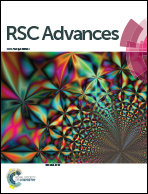Reinforcing effect on the tribological behaviour of nanoparticles due to a bimodal grain size distribution
Abstract
In this study, two kinds of calcite calcium carbonate nanoparticle additives (CN), with a grain size of ca. 30 nm and 80 nm, respectively, were synthesized via the carbonation method. Then, a series of additives were prepared through tuning the grain size distribution, and the corresponding tribological performances were also carefully investigated. Compared to the uniform size additives, the performance of the additives with a bimodal grain size distribution was obviously improved and the application range was further extended. Moreover, it can be observed that CN with a large grain size could improve tribological behavior under high frequency conditions, whereas the CN with a small grain size determined the load bearing capacity. The corresponding lubrication mechanisms were also investigated according to the characterization results of the wear scar surface, such as the morphology, composition and microstructure. The results indicated that a continuous protective film was formed on the contact surface and the corresponding mechanical properties determined the final lubricity. The enhancement of the tribological performance can be attributed to the improved toughness of the protective film, due to the reinforcing effect of the bimodal grain size distribution.


 Please wait while we load your content...
Please wait while we load your content...